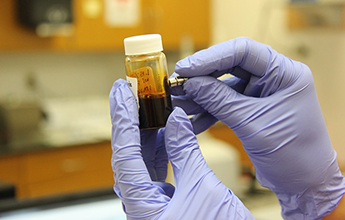
Science mimics life
Mystery of black widow spiders' steel-strength silk webs could lead to equally strong synthetic materials
Researchers at Northwestern University and San Diego State University (SDSU) have better unraveled the complex process of how black widow spiders transform proteins into steel-strength fibers. This knowledge promises to aid scientists in creating equally strong synthetic materials.
This article is part of a special feature highlighting Northwestern advances in nanotechnology.
Black widow spiders and their relatives, native to temperate climates in North America, Europe, Asia, Australia, Africa and South America, produce an array of silks with exceptional materials properties.
Scientists have long known the primary sequence of amino acids that make up some spider silk proteins and understood the structure of the fibers and webs. Previous research theorized that spider silk proteins await the spinning process as nano-size amphiphilic spherical micelles (clusters of water soluble and non-soluble molecules) before being funneled through the spider’s spinning apparatus to form silk fibers. However, when scientists attempted to replicate this process, they were unable to create synthetic materials with the strengths and properties of native spider silk fibers.
“The knowledge gap was literally in the middle,” Northwestern’s Nathan C. Gianneschi said. “What we didn’t understand completely is what goes on at the nanoscale in the silk glands or the spinning duct — the storage, transformation and transportation process involved in proteins becoming fibers.”


Utilizing state-of-the-art techniques — nuclear magnetic resonance (NMR) spectroscopy, the same technology utilized in MRI, at SDSU, followed by electron microscopy at Northwestern — the research team was able to more closely see inside the protein gland where the silk fibers originate, revealing a much more complex, hierarchical protein assembly. (Photo credit: SDSU)
This “modified micelles theory” concludes that spider silk proteins do not start out as simple spherical micelles, as previously thought, but instead as complex, compound micelles. This unique structure is potentially required to create the black widow spider’s impressive fibers.
“We now know that black widow spider silks are spun from hierarchical nano-assemblies (200 to 500 nanometers in diameter) of proteins stored in the spider’s abdomen, rather than from a random solution of individual proteins or from simple spherical particles,” said Greg Holland, co-corresponding author of the study and a professor at San Diego State University (SDSU).
“One cannot overstate the potential impact on materials and engineering if we can synthetically replicate this natural process to produce artificial fibers at scale,” Gianneschi said.
"The practical applications for a material like this are essentially limitless," added Holland.
Impact
The practical applications are limitless


Building materials for cable bridges and other construction

Environmentally-friendly replacements for plastics

Biomedical applications
The paper, titled "Hierarchical Spidroin Micellar Nanoparticles as the Fundamental Precursors of Spider Silks,” was published Oct. 22 in the Proceedings of the National Academy of Sciences. It was funded in part by the U.S. Department of Defense through the Air Force Office of Scientific Research and the Army Research Office.
Lucas Parent of Northwestern and David Onofrei of SDSU are the study's lead authors. Gianneschi and Holland are co-corresponding authors.
Gianneschi is the Jacob and Rosaline Cohn Professor in the department of chemistry in the Weinberg College of Arts and Sciences and in the departments of materials science and engineering and of biomedical engineering in the McCormick School of Engineering. He also is the associate director of the International Institute for Nanotechnology and a member of the Simpson Querrey Institute and the Chemistry of Life Processes Institute at Northwestern.
Holland is an associate professor in the department of chemistry and biochemistry at SDSU and the author of more than 40 papers on spider silk
 With venom more powerful than a rattle snake's, black widow spiders are the most venomous in North America. Researchers Nathan Gianneschi (left) and Greg Holland (right) followed strict safety standards while studying the spiders, which produce uniquely strong webs. Photo credit: SDSU
With venom more powerful than a rattle snake's, black widow spiders are the most venomous in North America. Researchers Nathan Gianneschi (left) and Greg Holland (right) followed strict safety standards while studying the spiders, which produce uniquely strong webs. Photo credit: SDSU
Published: October 22, 2018. Updated: May 21, 2020.
Back to top